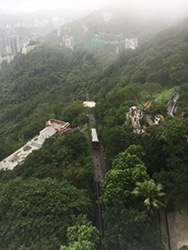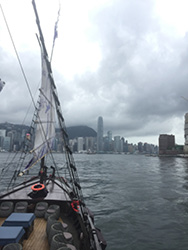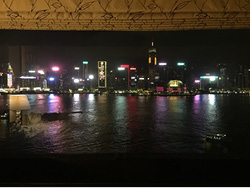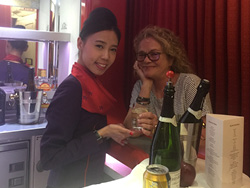Hong Kong for Beginners

Photo Jane Mundy SPONSORED CONTENT
No need for first timers to feel intimidated by the ‘Pearl of the Orient.’
Newcomers to Hong Kong will want to see everything and if you plan well, there’s no need to miss a thing, says writer Jane Mundy.
Newcomers to Hong Kong have every right to feel overwhelmed — at first.

Most city streets burst with commotion, sounds and smells, but there are also many places which are calm and serene. My advice is to plan ahead because there are so many things you’ll want to see and do without stressing out.
Start by getting an overview of the city in all its glory. Ride the Peak Tram — the steepest funicular railway in the world — to Victoria Peak and a view that stretches across skyscrapers to the green hills of the New Territories and down to the South China sea. And about eight million people.
Try to reserve ahead for a table overlooking Victoria Harbour at Lu Feng where dim sum is served all day and make sure to leave room for the black sesame roll, which is thought to make your hair shine.
Another great way to see the city is aboard the newly launched Aqua Luna II, a traditional red-sailed Chinese junk sailboat. The afternoon “hop on-hop off” Harbour Discovery tour is also an easy way to explore the city’s neighbourhoods in between relaxing on deck with a cold beverage.

Shopping
Gone are the days of great bargains and knock-offs, but you’ll find souvenirs and trinkets at the city’s markets. The Ladies’ Market on Tung Choi Street has more than 100 stalls full of what I can only describe as “stuff,” from clothing (typically sold in a size small) to cosmetics, while the Temple Street Night Market features electronic gadgets and toys. The Stanley Market has clothes in all sizes and chinoiserie (the European interpretation of Chinese art and gifts). If you like jade (the Chinese are obsessed with it) the Jade Market in Kowloon has jewelry and statues carved from the stone.
Many visitors travel to Hong Kong explicitly to shop for luxury goods and fill their days in massive, air-conditioned malls. The International Finance District Mall and Times Square are the most popular while the Landmark features high-end stores. Across the harbour in Kowloon is the mammoth Harbour City. If you shop ’til you drop, rest your weary feet at Pure Massage, also in Kowloon. Go for a 60-minute traditional reflexology treatment that might hurt a bit at first, but you’ll be thankful the next day.
Eating
Hong Kong is obsessed with food and the locals line up for dim sum at Tim Ho Wan, famous as being the “cheapest Michelin-starred restaurant” to offer the small plates. This Cantonese restaurant with its florescent lighting isn’t much to look at, but who cares when the food is this delicious and also moderately priced? Besides baskets of delicate and fragrant dim sum, try the double-boiled pear soup with snow fungus — it supposedly has medicinal qualities. Arrive early, leave your name at the door and go shopping for an hour in the mall upstairs. Tim Ho Wan is cash only.
How about lunch by a waterfall? When the hustle and bustle gets too frenetic, take a tranquil stroll at Nan Lian Garden, a meticulously landscaped 3.5 hectares where the cacophony of city life is replaced by songbirds. It’s here you’ll find the Chi Lin Nunnery and its vegetarian restaurant, served by Buddhist nuns and built under a waterfall.
Day Trip
Lantau Island is mandatory and the journey there alone is a photo opportunity. A 25-minute cable car ride, covering nearly five kilometers, offers breathtaking views of the South China Sea — it’s also home to the Hong Kong International Airport. At the top, surrounded by lush green hills, is the main attraction — at 112-feet tall, Big Buddha is the largest seated outdoor bronze Buddha in the world. And if you’re hungry, many restaurants on the island showcase the freshest, local seafood.
Getting Around
Hong Kong has terrific public transportation. Its MTR underground system is air-conditioned, squeaky clean, efficient and user-friendly. It’s a good idea to buy an Octopus card at the airport — good for most public transport — and take the airport express into town. Taxis are cheap compared to most cities, but if it’s rush hour(s) the MTR is much faster.
Where to Stay

Depending upon when you go, it’s possible to find a decent room for around $100 per night. The Hong Kong Tourism Board provides a list of hotels with Quality Tourism Services accreditation. I stayed two nights at Attitude on Granville (great location) and then moved to the InterContinental on Salisbury Street and didn’t want to leave the building. Perched on the Kawloon waterfront, the view from your room —especially at night when the waterfront skyscrapers put on a light show to music called the Symphony of Lights — is reason enough to splurge.
Attitude on Granville: attitudegranville.com

InterContinental Hong Kong: intercontinental.com
Getting there
Hong Kong Airlines soared into YVR in June to launch its daily flights between Vancouver and Hong Kong. And bonus: Both business and economy passengers can stretch their legs and order a cocktail at the stand-up SkyBar on this non-stop, 12-hour flight.
For more information about Hong Kong, visit DiscoverHongKong.com